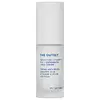What's inside
What's inside
 Key Ingredients
Key Ingredients

 Benefits
Benefits

 Concerns
Concerns

 Ingredients Side-by-side
Ingredients Side-by-side

Water
Skin ConditioningSilica
AbrasiveCetearyl Alcohol
EmollientSucrose Polystearate
EmollientTriheptanoin
Skin ConditioningPropanediol
SolventStearyl Alcohol
EmollientC13-16 Isoalkane
SolventCetyl Alcohol
EmollientGlycerin
HumectantSaccharomyces Ferment
Skin ConditioningDiheptyl Succinate
EmollientCassia Angustifolia Seed Extract
Skin ConditioningCarrageenan
Ascorbyl Glucoside
AntioxidantHelianthus Annuus Seed Oil
EmollientCentella Asiatica Extract
CleansingSalix Alba Bark Extract
AstringentVitis Vinifera Seed Oil
EmollientPanthenol
Skin ConditioningC13-15 Alkane
SolventCaprylyl Glycol
EmollientCapryloyl Glycerin/Sebacic Acid Copolymer
Skin ConditioningCetyl Palmitate
EmollientChlorphenesin
AntimicrobialLauroyl Lysine
Skin ConditioningXanthan Gum
EmulsifyingCitric Acid
BufferingPhenoxyethanol
PreservativePotassium Hydroxide
BufferingPotassium Sorbate
PreservativeSodium Formate
BufferingSodium Glycolate
BufferingSodium Hydroxide
BufferingSodium Stearoyl Glutamate
CleansingTetrasodium Glutamate Diacetate
Water, Silica, Cetearyl Alcohol, Sucrose Polystearate, Triheptanoin, Propanediol, Stearyl Alcohol, C13-16 Isoalkane, Cetyl Alcohol, Glycerin, Saccharomyces Ferment, Diheptyl Succinate, Cassia Angustifolia Seed Extract, Carrageenan, Ascorbyl Glucoside, Helianthus Annuus Seed Oil, Centella Asiatica Extract, Salix Alba Bark Extract, Vitis Vinifera Seed Oil, Panthenol, C13-15 Alkane, Caprylyl Glycol, Capryloyl Glycerin/Sebacic Acid Copolymer, Cetyl Palmitate, Chlorphenesin, Lauroyl Lysine, Xanthan Gum, Citric Acid, Phenoxyethanol, Potassium Hydroxide, Potassium Sorbate, Sodium Formate, Sodium Glycolate, Sodium Hydroxide, Sodium Stearoyl Glutamate, Tetrasodium Glutamate Diacetate
Water
Skin ConditioningParaffinum Liquidum
EmollientCaprylic/Capric Triglyceride
MaskingIsohexadecane
EmollientGlyceryl Stearate
EmollientPEG-100 Stearate
Glycerin
HumectantDimethicone
EmollientMethyl Gluceth-20
HumectantPropylene Glycol Alginate
Bakuchiol
AntimicrobialSimmondsia Chinensis Seed Oil
Emollient1,2-Hexanediol
Skin ConditioningCaprylyl Glycol
EmollientCarbomer
Emulsion StabilisingDimethicone Crosspolymer
Emulsion StabilisingDisodium EDTA
Glyceryl Linoleate
EmollientGlyceryl Linolenate
EmollientGlyceryl Oleate
EmollientGlyceryl Palmitate
EmollientGlycine Soja Oil
EmollientHydrogenated Starch Hydrolysate
HumectantPropylene Glycol
HumectantSodium Dextran Sulfate
Gel FormingSodium Hydroxide
BufferingTocopherol
AntioxidantTocopheryl Glucoside
EmollientVanilla Tahitensis Fruit Extract
Skin ConditioningWater, Paraffinum Liquidum, Caprylic/Capric Triglyceride, Isohexadecane, Glyceryl Stearate, PEG-100 Stearate, Glycerin, Dimethicone, Methyl Gluceth-20, Propylene Glycol Alginate, Bakuchiol, Simmondsia Chinensis Seed Oil, 1,2-Hexanediol, Caprylyl Glycol, Carbomer, Dimethicone Crosspolymer, Disodium EDTA, Glyceryl Linoleate, Glyceryl Linolenate, Glyceryl Oleate, Glyceryl Palmitate, Glycine Soja Oil, Hydrogenated Starch Hydrolysate, Propylene Glycol, Sodium Dextran Sulfate, Sodium Hydroxide, Tocopherol, Tocopheryl Glucoside, Vanilla Tahitensis Fruit Extract
Ingredients Explained
These ingredients are found in both products.
Ingredients higher up in an ingredient list are typically present in a larger amount.
Caprylyl Glycol is a humectant and emollient, meaning it attracts and preserves moisture.
It is a common ingredient in many products, especially those designed to hydrate skin. The primary benefits are retaining moisture, skin softening, and promoting a healthy skin barrier.
Though Caprylyl Glycol is an alcohol derived from fatty acids, it is not the kind that can dry out skin.
This ingredient is also used as a preservative to extend the life of products. It has slight antimicrobial properties.
Learn more about Caprylyl GlycolGlycerin is already naturally found in your skin. It helps moisturize and protect your skin.
A study from 2016 found glycerin to be more effective as a humectant than AHAs and hyaluronic acid.
As a humectant, it helps the skin stay hydrated by pulling moisture to your skin. The low molecular weight of glycerin allows it to pull moisture into the deeper layers of your skin.
Hydrated skin improves your skin barrier; Your skin barrier helps protect against irritants and bacteria.
Glycerin has also been found to have antimicrobial and antiviral properties. Due to these properties, glycerin is often used in wound and burn treatments.
In cosmetics, glycerin is usually derived from plants such as soybean or palm. However, it can also be sourced from animals, such as tallow or animal fat.
This ingredient is organic, colorless, odorless, and non-toxic.
Glycerin is the name for this ingredient in American English. British English uses Glycerol/Glycerine.
Learn more about GlycerinSodium Hydroxide is also known as lye or caustic soda. It is used to adjust the pH of products; many ingredients require a specific pH to be effective.
In small amounts, sodium hydroxide is considered safe to use. However, large amounts may cause chemical burns due to its high alkaline.
Your skin has a natural pH and acid mantle. This acid mantle helps prevent harmful bacteria from breaking through. The acid mantle also helps keep your skin hydrated.
"Alkaline" refers to a high pH level. A low pH level would be considered acidic.
Learn more about Sodium HydroxideWater. It's the most common cosmetic ingredient of all. You'll usually see it at the top of ingredient lists, meaning that it makes up the largest part of the product.
So why is it so popular? Water most often acts as a solvent - this means that it helps dissolve other ingredients into the formulation.
You'll also recognize water as that liquid we all need to stay alive. If you see this, drink a glass of water. Stay hydrated!
Learn more about Water